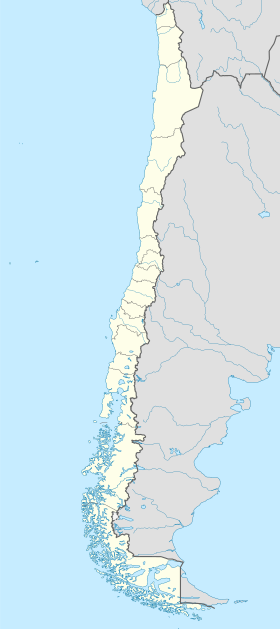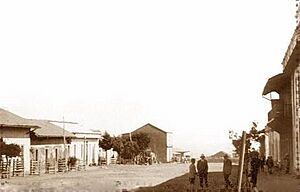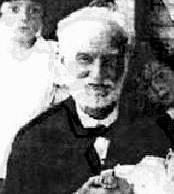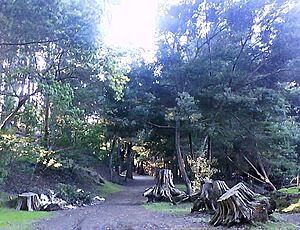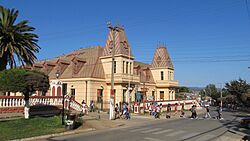Pichilemu facts for kids
Quick facts for kids
Pichilemu
|
|||||
|---|---|---|---|---|---|
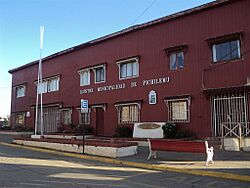
The Pichilemu city hall, as seen in April 2011
|
|||||
|
|||||
| Nickname(s):
Surf Capital (Capital del Surf)
|
|||||
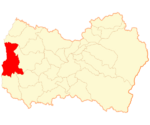
Location of the Pichilemu commune in O'Higgins Region
|
|||||
| Country | |||||
| Region | O'Higgins | ||||
| Province | Cardenal Caro | ||||
| Settled | 24 January 1544 | ||||
| Commune created | 22 December 1891 | ||||
| Area | |||||
| • Total | 749.1 km2 (289.2 sq mi) | ||||
| Elevation | 27 m (89 ft) | ||||
| Population
(2012 census)
|
|||||
| • Total | 13,916 | ||||
| • Density | 18.5770/km2 (48.114/sq mi) | ||||
| Demonym(s) | Pichilemino | ||||
| Time zone | UTC-4 (Chile Time (CLT)) | ||||
| • Summer (DST) | UTC-3 (Chile Summer Time (CLST)) | ||||
| ZIP codes |
3220478
|
||||
| Area code(s) | (+56) 72 | ||||
Pichilemu (pronounced pee-chee-LAY-moo) means "small forest" in the Mapudungún language. It is a popular beach city in central Chile. It is also the capital of Cardenal Caro Province in the O'Higgins Region. The area includes a main city center and many small villages like Ciruelos and Cáhuil. Pichilemu is located southwest of Santiago, Chile's capital. Over 13,000 people lived there in 2012.
Long ago, the Promaucaes people lived in the Pichilemu area. European development began in the mid-1500s. Pichilemu officially became a "commune" (a type of local government area) on December 22, 1891. Agustín Ross Edwards, a Chilean politician, wanted to turn it into a fancy beach resort. He hoped it would attract wealthy Chileans to the Pacific Ocean.
Pichilemu is home to five National Monuments of Chile. These include the Agustín Ross Cultural Centre and Agustín Ross Park. Other monuments are the old wooden railway station (Estación Pichilemu), El Árbol tunnel, and the Caballo de Agua. Part of the city was named a "Traditional Area" or "Heritage Site" in 2004.
The city has the main beach in the O'Higgins Region. It is a top spot for surfing, windsurfing, and funboarding. Many surf championships happen here each year at Punta de Lobos. Tourism is the main industry, but forestry and handicrafts are also important.
Contents
Exploring Pichilemu's Past
The Promaucaes people lived in Pichilemu before the Spanish arrived in Chile. They were hunter-gatherers and fishermen. They mostly lived along the Cachapoal River and Maule River. After the Spanish conquest, the remaining Promaucaes became part of Chilean society.
Historians have studied ancient sites in Pichilemu and Cáhuil. These sites show how the indigenous people lived long ago. For example, José Toribio Medina wrote a book in 1908 about the native remains found in Pichilemu. He confirmed that the Promaucaes lived there when the Spanish arrived.
During Chile's colonial and early independent periods, farming was very important. Large estates called haciendas were successful. One of these was the Hacienda San Antonio de Petrel in Pichilemu. It produced goods like leather and jerky, which were sold in Santiago and Valparaíso.
In 1872, a survey suggested Pichilemu was a good place for a ferry port. The Ortúzar family, who owned the San Antonio de Petrel hacienda, built a dock in 1875. This dock helped Pichilemu grow as a fishing port. Homes were built along what is now Daniel Ortúzar Avenue. The name Pichilemu comes from the Mapudungún words pichi (little) and lemu (forest).
During the 1891 Chilean Civil War, the dock was burned but later rebuilt. It was used until 1912. The town of Pichilemu was officially created as an "autonomous commune" on December 22, 1891. José María Caro Martínez became the first mayor in 1894. He helped improve the city's layout.
Agustín Ross Edwards, a Chilean writer and politician, bought land in Pichilemu in 1885. He wanted to make Pichilemu a summer resort for rich people from Santiago. He designed a beautiful area with a park and a forest. He turned his property into the Gran Hotel Pichilemu. He also built the Ross Casino (now a cultural center), chalets, and terraces. He imported building materials and furniture from France and England.
Agustín Ross died in 1926. His family later gave his buildings and land, including streets, parks, and forests, to the Municipality of Pichilemu. They wanted these places to be used for public enjoyment. The Agustín Ross Casino and Agustín Ross Park are now important parts of the city. They have been declared "Historic Monuments."
Pichilemu became the capital of the Cardenal Caro Province in 1979. The province is named after José María Caro Rodríguez, the first Chilean Catholic Cardinal, who was born in Pichilemu.
The city was badly hit by the 2010 Chile earthquake and the tsunami that followed. These events caused a lot of damage to the coastal area. On March 11, 2010, a strong 6.9 magnitude earthquake happened near Pichilemu.
Pichilemu's Natural Setting
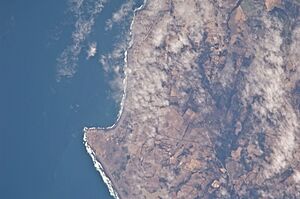
Pichilemu is located about 126 kilometers (78 miles) west of San Fernando. It is on the coast of the Pacific Ocean in the O'Higgins Region. The Andes Mountains are about a three-hour drive away. The city is also near the Cordillera de la Costa (Coastal Mountain Range), which can reach 2,000 meters (6,560 feet) high.
Pichilemu is bordered by Litueche to the north and Paredones to the south. To the east are Marchigüe and Pumanque. The Pacific Ocean lies to the west. The total area of Pichilemu is about 749.1 square kilometers (289.2 square miles).
The city is close to a geological fault called the Pichilemu Fault. This fault is about 15 kilometers (9 miles) deep. It is not known if the fault formed during the March 2010 earthquake or if it was just reactivated.
Most of the forest areas around Pichilemu have pine and eucalyptus trees. However, a native forest, now called the Municipal Forest, still exists. It has local trees like litres, quillayes, and boldos.
Pichilemu has a Mediterranean climate. This means it has rainy winters, with about 700 millimeters (27.5 inches) of rain. The rest of the year is dry and often windy. Sometimes, strong winds up to 150 kilometers per hour (93 miles per hour) can hit the city.
Who Lives in Pichilemu?
| Historical population | ||
|---|---|---|
| Year | Pop. | ±% |
| 1777—1779 | 1,743 | — |
| 1787 | 1,687 | −3.2% |
| 1813 | 5,705 | +238.2% |
| 1875 | 5,569 | −2.4% |
| 1885 | 6,957 | +24.9% |
| 1895 | 6,930 | −0.4% |
| 1907 | 7,787 | +12.4% |
| 1920 | 7,424 | −4.7% |
| 1930 | 6,929 | −6.7% |
| 1940 | 6,570 | −5.2% |
| 1952 | 7,150 | +8.8% |
| 1960 | 8,015 | +12.1% |
| 1970 | 8,042 | +0.3% |
| 1982 | 8,844 | +10.0% |
| 1992 | 10,510 | +18.8% |
| 2002 | 12,392 | +17.9% |
| Source: Grez-Cañete (2017) | ||
In the 17th century, Pichilemu had 1,468 people. By 1895, the population grew to 11,829. After that, the population went down for a while, then started to grow again. In 2002, there were 12,392 people living in Pichilemu. About 76% lived in urban areas, and 24% lived in rural areas.
Most people in Pichilemu are Catholic. In 2002, about 83% of the people were Catholic. A smaller number, about 7.5%, were evangelical. Some people also identified as Atheist or Agnostic, or belonged to other religions.
How Pichilemu is Governed
Pichilemu is part of Electoral District No. 16 in Chile. This means it joins with many other towns to elect representatives.
The city is led by a mayor (alcalde). The mayor handles the city's daily operations. The City Council (concejo municipal) makes the laws for the city. Both the mayor and council members are elected by the people every four years. They can be re-elected.
The current mayor of Pichilemu is Cristian Pozo Parraguez. He started his term in June 2021. The city council members are Danilo Robles Cáceres, Mario Morales Cárceles, Sofía Yávar Ramírez, José Luis Cabrera Jorquera, Tobías Acuña Csillag, and Hugo Toro Galaz. Their term will end in December 2024.
The local police in Pichilemu are called Carabineros de Pichilemu. Their main station is on Daniel Ortúzar Avenue.
What Pichilemu Produces
Tourism is the most important industry in Pichilemu. People visit the city center and nearby rural areas like Cáhuil and Ciruelos. Another big industry is forestry, which involves growing and harvesting trees like pine and eucalyptus.
Pichilemu is also known for its handicrafts. Fishing is common in Pichilemu, Bucalemu, and Navidad, even though it's not a huge industry for the whole region.
The area around Pañul has clay deposits. People have been making pottery here for a very long time, since around 300 BCE. Today, villages like Ciruelos and El Copao are famous for their pottery.
Places to Visit in Pichilemu
The Bosque Municipal (Municipal Forest) was given to the city by the Ross family in 1935. You can enter the forest near the Ross Casino. It has paths surrounded by palms, pines, and many other trees. It's a great place for a walk.
The Conchal Indígena (Indigenous Midden) is an old archaeological site from before the Spanish arrived. It's located about 1 kilometer (0.6 miles) from Punta de Lobos. It was once an ancient fishing village.
Laguna Los Curas (Los Curas Lagoon) is a natural area for eco-tourism, like fishing. It's about 7 kilometers (4.3 miles) south of Pichilemu. Another lagoon, Laguna del Perro (The Dog's Lagoon), is about 8.5 kilometers (5.3 miles) south and is used for fun activities.
St. Andrew Church is in Ciruelos, about 13 kilometers (8 miles) from Pichilemu. It was built in 1779. The church has old images of saints and a harmonium. Cardinal José María Caro Rodríguez was baptized here. The feast day of St. Andrew is celebrated every November 30.
The Museo del Niño Rural (the Rural Kid Museum) was started by a teacher, Carlos Leyton, and his students. It's a modern building that looks like traditional architecture. Inside, you can see stone tools, arrowheads, and clay tools made by the local indigenous people. There are also old household tools from early colonists.
El Copao is a small village about 14 kilometers (8.7 miles) east of Pichilemu. Its main activity is making pottery from local clay. Pañul is another village, about 17 kilometers (10.5 miles) away. Its name means "medicinal herb" in Mapudungún. Pañul also makes pottery from local clay.
Cáhuil is a small village about 13 kilometers (8 miles) south of Pichilemu. Its name means "parrot place." The Cáhuil lagoon is used for fishing, swimming, and kayaking. You can even take kiteboarding lessons there. The Cáhuil Bridge offers great views and connects to other nearby towns.
Pichilemu was declared a "Typical Zone" (a heritage site) by Chile's National Monuments Council in 2004.
Agustín Ross Cultural Centre
The Agustín Ross Cultural Centre is a three-story building. It was built in the early 1900s by Agustín Ross using imported materials. It was Chile's first casino, opening on January 20, 1906. It operated until 1932.
The building was renovated and reopened in 2009 as a cultural arts center. It now has art galleries and the public library. During its restoration, workers found old items like a newspaper from 1941 and a telephone battery from the early 1900s.
Ross Park was created by Agustín Ross in 1885. It has very old native Chilean palms and lots of green spaces. It was restored in 1987 and is now a popular place for walks. The former casino and the park were named National Monuments in 1988.
The Ross Hotel was also created by Agustín Ross in 1885. It was first called Gran Hotel Pichilemu. It is one of the oldest hotels in Chile. It is still partly open to guests, but it needs some repairs.
The Historic Railway Station
The old wooden railway station, Estación Pichilemu, was built around 1925. It is one of Chile's National Monuments of Chile. A railway line connected Pichilemu to San Fernando. Passenger trains ran until 1986, and freight trains until 1995. The section of the railway to Pichilemu was removed in 2006.
The station was named a National Monument in 1994. Today, it is an arts and culture center and a tourism information office. It displays objects and old clothes from the 1920s.
Pichilemu's Amazing Beaches
Pichilemu has several wide beaches with dark sand. The water is cool all year. Many tourists enjoy swimming near the shore in summer. Popular activities include bodyboarding, surfing, windsurfing, and kitesurfing.
Playa Las Terrazas, or Main Beach, is the northernmost beach. It is in front of Ross Park and is popular for surfing. Near the beach, you can see old stone railings and stairs from the early 1900s. There's also a balcony overlooking the rocks. This beach is the busiest in summer. You can find surf schools and a fish market nearby.
South of the town is Playa Infiernillo (Little Hell Beach). It is rocky and has tide pools, making it good for fishing. Even further south is Playa Hermosa (Beautiful Beach), which is great for walking and fishing.
About 6 kilometers (3.7 miles) south of Pichilemu is Punta de Lobos. This beach is protected from southern winds. It's a very popular spot for tourists and surfers. Many surf contests are held here every year. The waves can be huge, reaching up to 15 meters (49 feet) in fall and winter. It is known as one of the best surfing beaches in the world. In 2012, it was named one of the "50 most thrilling surf destinations."
Pichilemu is considered the best place for surfing in Chile, especially at Punta de Lobos. International surf championships happen at La Puntilla Beach every October and December. Punta de Lobos also hosts the National Surfing Championship every summer.
Media and News
Pichilemu has a local newspaper called La Voz de la Región ("The Voice of the Region"). It comes out every two weeks. Other newspapers, like El Expreso de la Costa and El Faro del Secano, stopped publishing a few years ago.
You can listen to several radio stations in Pichilemu. These include Radio Entreolas, Radio Atardecer, and Radio Somos Pichilemu. There is also a local television channel called Canal 3 Pichilemu.
Learning in Pichilemu
Pichilemu has several schools. These include Liceo Agustín Ross Edwards (Agustín Ross Edwards High School) and Charly's School. There's also Escuela Digna Camilo Aguilar and Colegio Libertadores. Other schools are Colegio de la Preciosa Sangre and Colegio Divino Maestro. For younger kids, there's Jardín Amanecer (Dawn Garden), a kindergarten.
Higher education (like college) first came to Pichilemu in 1970, but it didn't last long. In 2002, the Universidad Academia de Humanismo Cristiano (Academy of Christian Humanism University) started offering classes. In 2011, it was announced that a new higher education institute, IPG Professional Institute, would open in the province.
See also
 In Spanish: Pichilemu para niños
In Spanish: Pichilemu para niños





